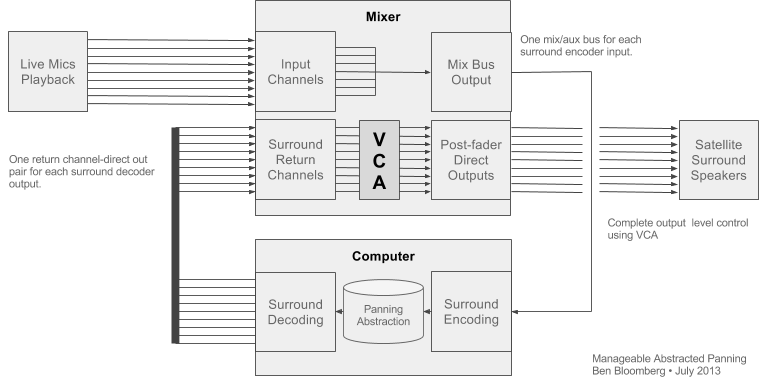Abstracted panning is a term I use for systems that have some mechanism for placing sound in space independently of the physical speaker outputs. These systems allow sound designers to work spatially, rather than set specific levels to various speakers around the room– the panning system automatically distributes the sound across speakers according to the designer’s intention. There are many commercial abstracted panning systems available, the most popular being Meyer Dmitri (originally LCS). However, these systems often cost upward of $80,000 and can be fairly complicated to set up.
Over the years, we’ve developed all sorts of less expensive alternatives. These typically use a computer for the encoding and decoding of various surround sound formats, but a recurring problem is that many mixers do not come with enough mix busses to easily handle 24 or more outputs. Even the Studer Vista console we used for Death and the Powers system, which has hundreds of channels of surround sound, couldn’t realistically work. We needed about 80 busses for traditional sound design stuff like effects, so there wasn’t available DSP remaining for another 143 speaker outputs.
At the same time, with many speakers, its critical to have hardware control of levels very easily in the mixer. Having that control prevents a whole lot of headaches and allows some creative mixing techniques. So, here’s a simple method I use pretty frequently to deal with large surround matrixes on smaller mixers.
- Use a mix bus or aux send for each surround encoder input (think of these as panners that work around the entire room). This allows very flexible routing to the surround sound system and allows many inputs to be lumped together into discrete bunches that can be placed in space.
- The abstracted location of each panner is controlled somehow (maybe via OSC or MIDI from QLab). I’ll talk about control systems and various computer based panning systems in another post!
- Route each surround decoder back to an input on the mixer. There should be a separate decoder for each speaker with unique outputs. To control the level of the decoders, we’ll use channels and direct outs on the mixer. This means that it must be possible to set the direct outs to be post-fader on your mixer, but it also means we can devote our channel DSP to speaker outputs which is very handy especially on digital consoles with delay and EQ on every input.
- Assign each of these surround return channels to a single VCA. This allows level shading using the individual faders and master control on a single VCA fader! Voila!
This is hopefully illustrated with some clarity by the diagram below! I find myself building this configuration very frequently, so I thought it would be good to document.

Photo by John!